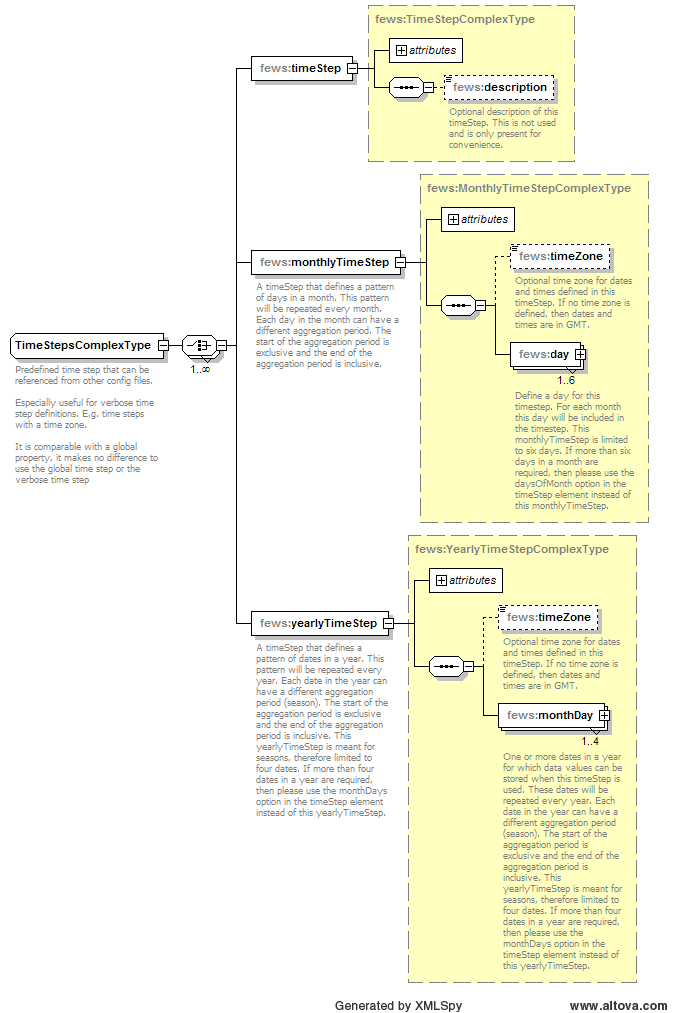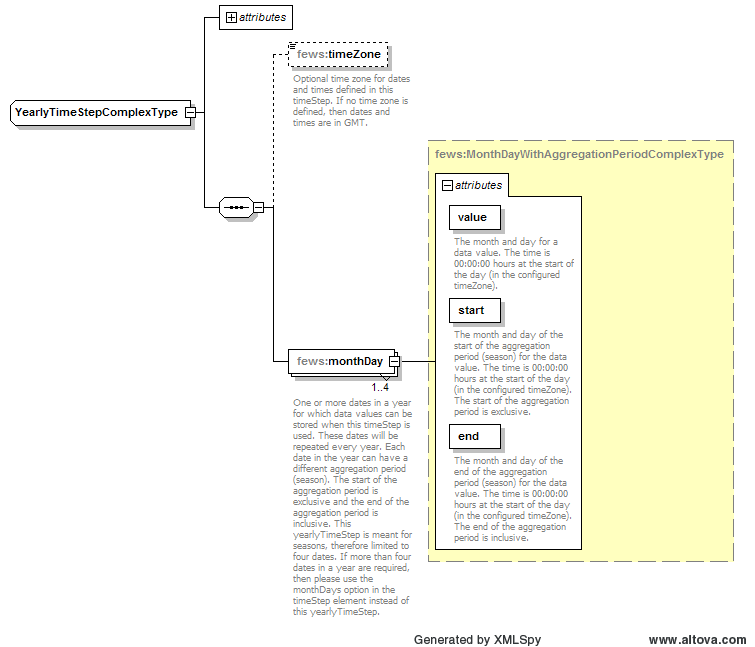Function: | Configure predefined timesteps for a fews environment |
Where to Use? | To define verbose timesteps or to define yearly or monthly time steps |
Why to Use? | Yearly and monthly time steps can only be configured in the timesteps.xml. For verbose timesteps it might be |
Description: | Definition of timesteps which can be referenced from other configuration files |
Available since: |
|
Contents
Overview
The timesteps.xml can be used to configure timesteps. This file is useful to define verbose timesteps and refer to the definition of these timesteps to
from other configuration files.
Configuration
When available on the file system, the name of the XML file is for example:
TimeSteps 1.00 default.xml
TimeSteps Fixed file name for the TimeSteps configuration
1.00 Version number
default Flag to indicate the version is the default configuration (otherwise omitted).
Schema
Below the schema of the TimeStep.xml configuration files.
timeStep
Attributes;
- id: Unique Id of level threshold. This id should be used when referencing to this definition from other configuration files.
The following link describes in detail of to configure a timestep.
yearlyTimeStep
A timeStep that defines a pattern of dates in a year. This pattern will be repeated every year.
Each date in the year can have a different aggregation period (season).
The start of the aggregation period is exclusive and the end of the aggregation period is inclusive.
This yearlyTimeStep is meant for seasons, therefore limited to four dates.
If more than four dates in a year are required, then please use the monthDays option in the timeStep element instead of this yearlyTimeStep
Schema yearly time step
Below the schema of the yearly time step
Below a configuration example
<yearlyTimeStep id="daily"> <monthDay start="--01-01" end="--01-02" value="--01-02"/> <monthDay start="--04-02" end="--04-03" value="--04-03"/> <monthDay start="--07-03" end="--07-04" value="--07-04"/> <monthDay start="--10-04" end="--10-05" value="--10-05"/> </yearlyTimeStep>
To define a yearly time step an id should be configured. Secondly the monthDays of the time steps should be configured.
In this example the yearly time step has 4 monthDays. The start attribute defines the start of the aggregation period and the
end tag defines the end of the aggregation period. The value defines the value of the monthDay itself.
Monthly time step
A timeStep that defines a pattern of days in a month. This pattern will be repeated every month. Each day in the month can have a different aggregation period. The start of the aggregation period is exclusive and the end of the aggregation period is inclusive.
Schema monthly time step
Below the schema of the monthly time step.
Below a configuration example
<monthlyTimeStep id="example"> <day start="01" end="02" value="02"></day> <day start="10" end="11" value="11"></day> </monthlyTimeStep>
Weekly timestep
A timestep that defines a pattern of times in week. This pattern will be repeated every week (since 2014.01). In this example values stored for this timestep are stored on Sunday, 00:00. This could be useful if the default weekly time (Thursday) is not suitable.
<weeklyTimeStep id="Week" label="week">
<sunday times="00:00"/>
</weeklyTimeStep>
Other examples
every day at 13:00
<timeStep times="13:00"/>
every day at 13:00 and 20:00
<timeStep times="13:00 20:00"/>
every hour at each half hour (0:30, 1:30, etc.)
<timeStep minutes="30"/>
every hour at 5 and 45 minutes
<timeStep minutes="05 45">
every 12th of the month
<timeStep daysOfMonth="12"/>
decade
<timeStep daysOfMonth="1 11 21"/>


